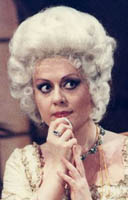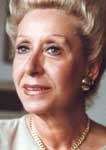Filth!
The Female Countertenor
 And by "countertenor," I don't mean any of those wonderful modern-day
artists like David Daniels, either. I mean the kind of countertenor
you used to hear back in the 1950s, the kind that gave "countertenor" a
bad name. You know, vibratoless, whiny, bleaty, unlistenable? Well, I've
put it off long enough; we're going to have to hear those sound clips sooner
or later. Might as well just jump right in, as into an icy river. And, come
to think of it, "icy" is one very appropriate adjective for the singing of
our "female countertenor," Mara Zampieri. La Cieca supposes that in
certain roles, the harsh, vibrato-free tone might make some sense; Lady Macbeth,
maybe. Maybe. But here's Mara in performance of a couple of the gems
of the Italian art song repertoire. They may never sound the same to you
again...
E strano . . .
And by "countertenor," I don't mean any of those wonderful modern-day
artists like David Daniels, either. I mean the kind of countertenor
you used to hear back in the 1950s, the kind that gave "countertenor" a
bad name. You know, vibratoless, whiny, bleaty, unlistenable? Well, I've
put it off long enough; we're going to have to hear those sound clips sooner
or later. Might as well just jump right in, as into an icy river. And, come
to think of it, "icy" is one very appropriate adjective for the singing of
our "female countertenor," Mara Zampieri. La Cieca supposes that in
certain roles, the harsh, vibrato-free tone might make some sense; Lady Macbeth,
maybe. Maybe. But here's Mara in performance of a couple of the gems
of the Italian art song repertoire. They may never sound the same to you
again...
E strano . . .
A truly unique interpretation of Violetta's Act One scena was sung by Sari Bunchuk Wontner, a Las Vegas socialite and enthusiastic amateur soprano circa 1980. This excerpt was recorded at one of the programs of operatic scenes she presented in her lovely home, staged and with full orchestra. In fact, this was her final Traviata before her tragic end, when she fell overboard the Wontner family yacht in the Carribean.
This performance is from the VAI release The Muse Surmounted, highly recommended!
If there is one singer who can be called "Queen of Filth," that would have to be Anna Moffo. After a brilliant if erratic
career at the Met and in the world's other great (and not-so-great) opera houses, Ms.
Moffo fell victim to a vocal crisis in the mid 1970s from which she never
recovered. For reasons best known to herself, the diva continued to perform
in public, as recently as the 1990s. This bizarre clip demonstrates Moffo's
vocal estate in 1995, when she performed the song
La danza at some sort of outdoor
concert. In fairness to la Moffo, it should be noted that she was a wonderful
singer in her prime, with a uniquely sensuous timbre allied to a brilliant
coloratura technique -- besides her great personal beauty. This excerpt from
Die Fledermaus
shows off Moffo at her considerable best.
After a brilliant if erratic
career at the Met and in the world's other great (and not-so-great) opera houses, Ms.
Moffo fell victim to a vocal crisis in the mid 1970s from which she never
recovered. For reasons best known to herself, the diva continued to perform
in public, as recently as the 1990s. This bizarre clip demonstrates Moffo's
vocal estate in 1995, when she performed the song
La danza at some sort of outdoor
concert. In fairness to la Moffo, it should be noted that she was a wonderful
singer in her prime, with a uniquely sensuous timbre allied to a brilliant
coloratura technique -- besides her great personal beauty. This excerpt from
Die Fledermaus
shows off Moffo at her considerable best.
 A very different sort of artist is Helga Dernesch.
By nature most likely a mezzo-soprano, she performed as a dramatic soprano
in some of the world's most prestigous venues, in particular the Salzburg
Festival, where she was a favorite of Herbert von Karajan.
Eventually, the strain of the upward extension took its toll and Dernesch
withdrew from public performance to restudy her technique in her natural
Fach, and she enjoyed a distinguished second career in such roles as Waltraute,
Herodias and the Old Countess in Queen of Spades. We hear Mme. Dernesch
toward the end of her soprano career, as
Ariadne in 1977, when
she could accurately be called "topless!"
A very different sort of artist is Helga Dernesch.
By nature most likely a mezzo-soprano, she performed as a dramatic soprano
in some of the world's most prestigous venues, in particular the Salzburg
Festival, where she was a favorite of Herbert von Karajan.
Eventually, the strain of the upward extension took its toll and Dernesch
withdrew from public performance to restudy her technique in her natural
Fach, and she enjoyed a distinguished second career in such roles as Waltraute,
Herodias and the Old Countess in Queen of Spades. We hear Mme. Dernesch
toward the end of her soprano career, as
Ariadne in 1977, when
she could accurately be called "topless!"
More filth:
Under the Rainbow (Renee does Judy)
Mozart's Alarm Clock (Elinor Ross)
The Note that Got Away (Nicolai Gedda)
What the F? (Enrico di Giuseppe)
It Was Puccini's Idea (Franco Bonisolli speaks!)
Letter Perfect (The inimitable Mari Lynn)
 And by "countertenor," I don't mean any of those wonderful modern-day
artists like David Daniels, either. I mean the kind of countertenor
you used to hear back in the 1950s, the kind that gave "countertenor" a
bad name. You know, vibratoless, whiny, bleaty, unlistenable? Well, I've
put it off long enough; we're going to have to hear those sound clips sooner
or later. Might as well just jump right in, as into an icy river. And, come
to think of it, "icy" is one very appropriate adjective for the singing of
our "female countertenor," Mara Zampieri. La Cieca supposes that in
certain roles, the harsh, vibrato-free tone might make some sense; Lady Macbeth,
maybe. Maybe. But here's Mara in performance of a couple of the gems
of the Italian art song repertoire. They may never sound the same to you
again...
E strano . . .
And by "countertenor," I don't mean any of those wonderful modern-day
artists like David Daniels, either. I mean the kind of countertenor
you used to hear back in the 1950s, the kind that gave "countertenor" a
bad name. You know, vibratoless, whiny, bleaty, unlistenable? Well, I've
put it off long enough; we're going to have to hear those sound clips sooner
or later. Might as well just jump right in, as into an icy river. And, come
to think of it, "icy" is one very appropriate adjective for the singing of
our "female countertenor," Mara Zampieri. La Cieca supposes that in
certain roles, the harsh, vibrato-free tone might make some sense; Lady Macbeth,
maybe. Maybe. But here's Mara in performance of a couple of the gems
of the Italian art song repertoire. They may never sound the same to you
again...
E strano . . . A truly unique interpretation of Violetta's Act One scena was sung by Sari Bunchuk Wontner, a Las Vegas socialite and enthusiastic amateur soprano circa 1980. This excerpt was recorded at one of the programs of operatic scenes she presented in her lovely home, staged and with full orchestra. In fact, this was her final Traviata before her tragic end, when she fell overboard the Wontner family yacht in the Carribean.
This performance is from the VAI release The Muse Surmounted, highly recommended!
If there is one singer who can be called "Queen of Filth," that would have to be Anna Moffo.
 After a brilliant if erratic
career at the Met and in the world's other great (and not-so-great) opera houses, Ms.
Moffo fell victim to a vocal crisis in the mid 1970s from which she never
recovered. For reasons best known to herself, the diva continued to perform
in public, as recently as the 1990s. This bizarre clip demonstrates Moffo's
vocal estate in 1995, when she performed the song
La danza at some sort of outdoor
concert. In fairness to la Moffo, it should be noted that she was a wonderful
singer in her prime, with a uniquely sensuous timbre allied to a brilliant
coloratura technique -- besides her great personal beauty. This excerpt from
Die Fledermaus
shows off Moffo at her considerable best.
After a brilliant if erratic
career at the Met and in the world's other great (and not-so-great) opera houses, Ms.
Moffo fell victim to a vocal crisis in the mid 1970s from which she never
recovered. For reasons best known to herself, the diva continued to perform
in public, as recently as the 1990s. This bizarre clip demonstrates Moffo's
vocal estate in 1995, when she performed the song
La danza at some sort of outdoor
concert. In fairness to la Moffo, it should be noted that she was a wonderful
singer in her prime, with a uniquely sensuous timbre allied to a brilliant
coloratura technique -- besides her great personal beauty. This excerpt from
Die Fledermaus
shows off Moffo at her considerable best.  A very different sort of artist is Helga Dernesch.
By nature most likely a mezzo-soprano, she performed as a dramatic soprano
in some of the world's most prestigous venues, in particular the Salzburg
Festival, where she was a favorite of Herbert von Karajan.
Eventually, the strain of the upward extension took its toll and Dernesch
withdrew from public performance to restudy her technique in her natural
Fach, and she enjoyed a distinguished second career in such roles as Waltraute,
Herodias and the Old Countess in Queen of Spades. We hear Mme. Dernesch
toward the end of her soprano career, as
Ariadne in 1977, when
she could accurately be called "topless!"
A very different sort of artist is Helga Dernesch.
By nature most likely a mezzo-soprano, she performed as a dramatic soprano
in some of the world's most prestigous venues, in particular the Salzburg
Festival, where she was a favorite of Herbert von Karajan.
Eventually, the strain of the upward extension took its toll and Dernesch
withdrew from public performance to restudy her technique in her natural
Fach, and she enjoyed a distinguished second career in such roles as Waltraute,
Herodias and the Old Countess in Queen of Spades. We hear Mme. Dernesch
toward the end of her soprano career, as
Ariadne in 1977, when
she could accurately be called "topless!" More filth:
Under the Rainbow (Renee does Judy)
Mozart's Alarm Clock (Elinor Ross)
The Note that Got Away (Nicolai Gedda)
What the F? (Enrico di Giuseppe)
It Was Puccini's Idea (Franco Bonisolli speaks!)
Letter Perfect (The inimitable Mari Lynn)

